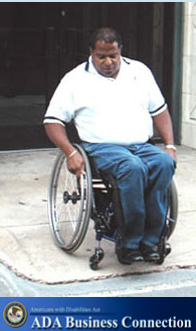Expanding Your Market: Maintaining Accessible Features in Retail Establishments
Introduction

Inoperable elevators, locked accessible doors, or routes that are obstructed by furniture or merchandise make buildings inaccessible to and unusable by customers with disabilities.
More than 50 million Americans with disabilities are potential customers for retail businesses across the country. These 50-million-plus customers, along with their families and friends, patronize clothing boutiques, mall outlets, grocery stores, and more, if the businesses are accessible. This market grows even larger if the 78 million baby boomers in this country - who do not always require but benefit from accessibility - are included. Accessibility makes good business sense: an accessible retail establishment brings in new customers and keeps them coming back again and again.
The Americans with Disabilities Act (ADA) requires businesses that serve the public to remove barriers from older buildings and to design and build new facilities to provide access to customers with disabilities. A key component of ADA compliance is maintaining those features so they remain usable. Businesses spend money to remove barriers. And, businesses need to protect that investment. Even brand-new buildings designed for complete accessibility can become inaccessible without proper attention. If key elements - often including the parking, building entrance, route into and through the establishment, access to the store's goods and services, restrooms, cashier stations, and egress - are not maintained, then access is reduced or eliminated. A poorly placed trashcan or a locked door can make a building unusable. Now that is a waste of money.
This document identifies ways that businesses can maintain their investment in access with little or no extra cost. Issues will vary, of course, with individual retail establishments.
Visit the U.S. Department of Justice's ADA Business Connection website at www.ada.gov for more information about accessibility in retail establishments, including "Reaching Out to Customers with Disabilities," the Department's ADA online course.

User Comments/Questions
Add Comment/Question